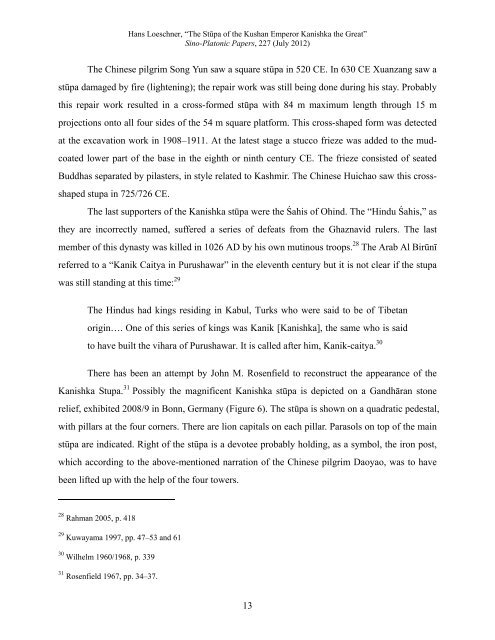The Stūpa of the Kushan Emperor Kanishka the - Sino-Platonic Papers
The Stūpa of the Kushan Emperor Kanishka the - Sino-Platonic Papers
The Stūpa of the Kushan Emperor Kanishka the - Sino-Platonic Papers
Create successful ePaper yourself
Turn your PDF publications into a flip-book with our unique Google optimized e-Paper software.
Hans Loeschner, “<strong>The</strong> <strong>Stūpa</strong> <strong>of</strong> <strong>the</strong> <strong>Kushan</strong> <strong>Emperor</strong> <strong>Kanishka</strong> <strong>the</strong> Great”<br />
<strong>Sino</strong>-<strong>Platonic</strong> <strong>Papers</strong>, 227 (July 2012)<br />
<strong>The</strong> Chinese pilgrim Song Yun saw a square stūpa in 520 CE. In 630 CE Xuanzang saw a<br />
stūpa damaged by fire (lightening); <strong>the</strong> repair work was still being done during his stay. Probably<br />
this repair work resulted in a cross-formed stūpa with 84 m maximum length through 15 m<br />
projections onto all four sides <strong>of</strong> <strong>the</strong> 54 m square platform. This cross-shaped form was detected<br />
at <strong>the</strong> excavation work in 1908–1911. At <strong>the</strong> latest stage a stucco frieze was added to <strong>the</strong> mud-<br />
coated lower part <strong>of</strong> <strong>the</strong> base in <strong>the</strong> eighth or ninth century CE. <strong>The</strong> frieze consisted <strong>of</strong> seated<br />
Buddhas separated by pilasters, in style related to Kashmir. <strong>The</strong> Chinese Huichao saw this cross-<br />
shaped stupa in 725/726 CE.<br />
<strong>The</strong> last supporters <strong>of</strong> <strong>the</strong> <strong>Kanishka</strong> stūpa were <strong>the</strong> Śahis <strong>of</strong> Ohind. <strong>The</strong> “Hindu Śahis,” as<br />
<strong>the</strong>y are incorrectly named, suffered a series <strong>of</strong> defeats from <strong>the</strong> Ghaznavid rulers. <strong>The</strong> last<br />
member <strong>of</strong> this dynasty was killed in 1026 AD by his own mutinous troops. 28 <strong>The</strong> Arab Al Birūnī<br />
referred to a “Kanik Caitya in Purushawar” in <strong>the</strong> eleventh century but it is not clear if <strong>the</strong> stupa<br />
was still standing at this time: 29<br />
<strong>The</strong> Hindus had kings residing in Kabul, Turks who were said to be <strong>of</strong> Tibetan<br />
origin…. One <strong>of</strong> this series <strong>of</strong> kings was Kanik [<strong>Kanishka</strong>], <strong>the</strong> same who is said<br />
to have built <strong>the</strong> vihara <strong>of</strong> Purushawar. It is called after him, Kanik-caitya. 30<br />
<strong>The</strong>re has been an attempt by John M. Rosenfield to reconstruct <strong>the</strong> appearance <strong>of</strong> <strong>the</strong><br />
<strong>Kanishka</strong> Stupa. 31 Possibly <strong>the</strong> magnificent <strong>Kanishka</strong> stūpa is depicted on a Gandhāran stone<br />
relief, exhibited 2008/9 in Bonn, Germany (Figure 6). <strong>The</strong> stūpa is shown on a quadratic pedestal,<br />
with pillars at <strong>the</strong> four corners. <strong>The</strong>re are lion capitals on each pillar. Parasols on top <strong>of</strong> <strong>the</strong> main<br />
stūpa are indicated. Right <strong>of</strong> <strong>the</strong> stūpa is a devotee probably holding, as a symbol, <strong>the</strong> iron post,<br />
which according to <strong>the</strong> above-mentioned narration <strong>of</strong> <strong>the</strong> Chinese pilgrim Daoyao, was to have<br />
been lifted up with <strong>the</strong> help <strong>of</strong> <strong>the</strong> four towers.<br />
28 Rahman 2005, p. 418<br />
29 Kuwayama 1997, pp. 47–53 and 61<br />
30 Wilhelm 1960/1968, p. 339<br />
31 Rosenfield 1967, pp. 34–37.<br />
13

















